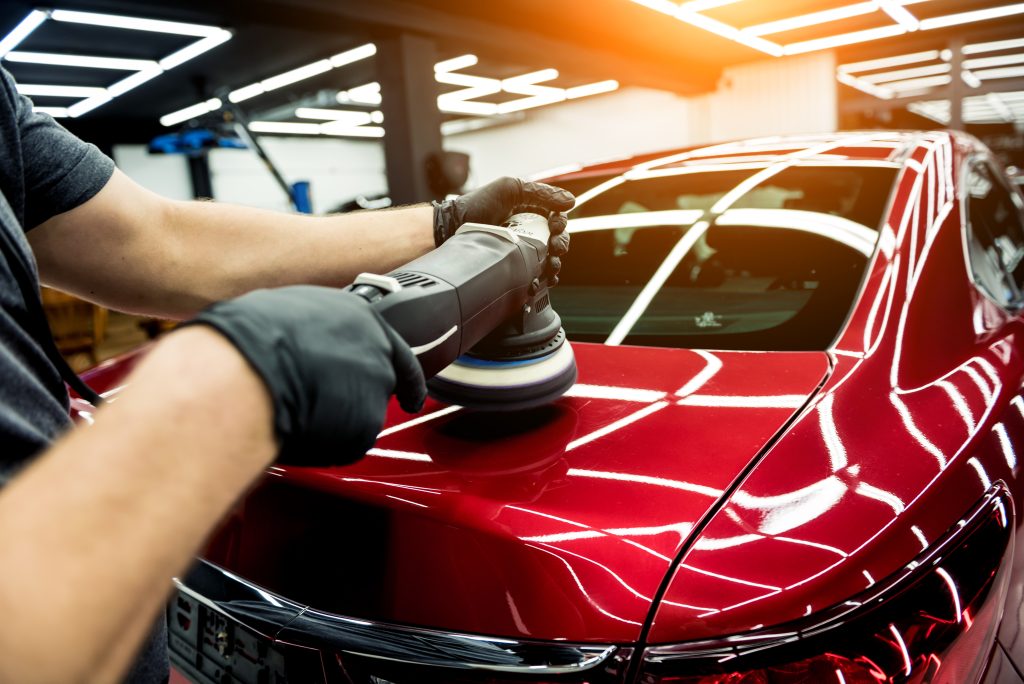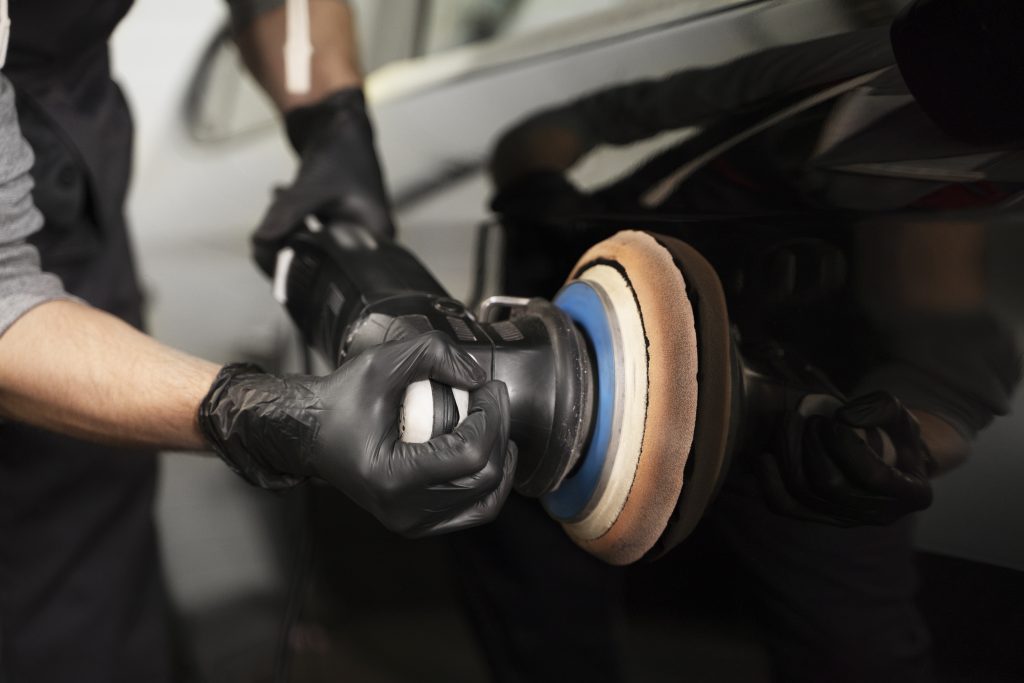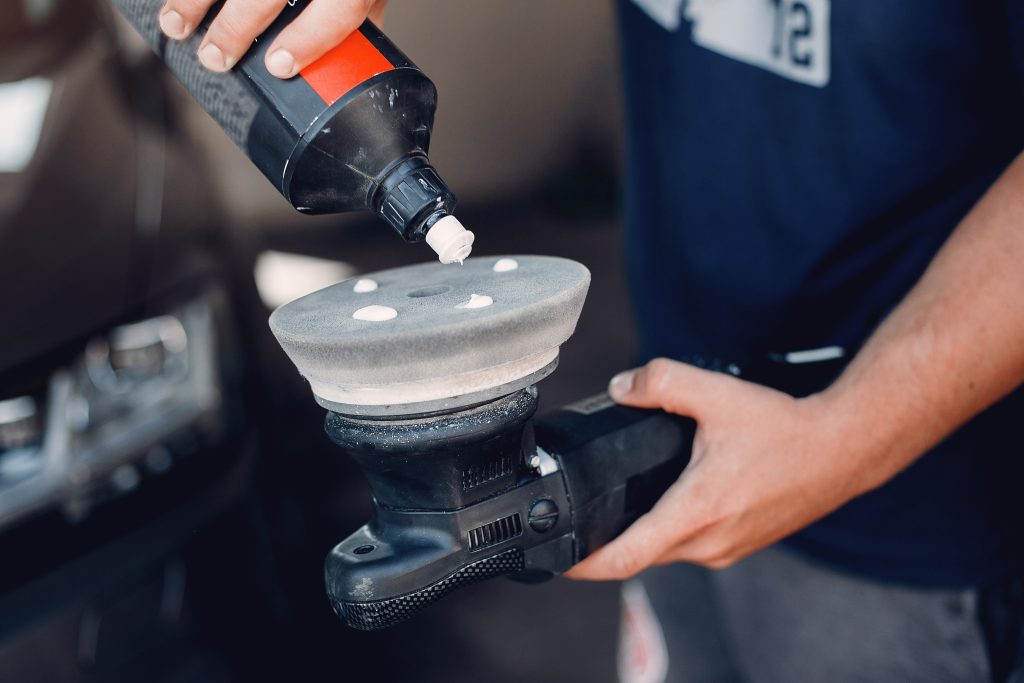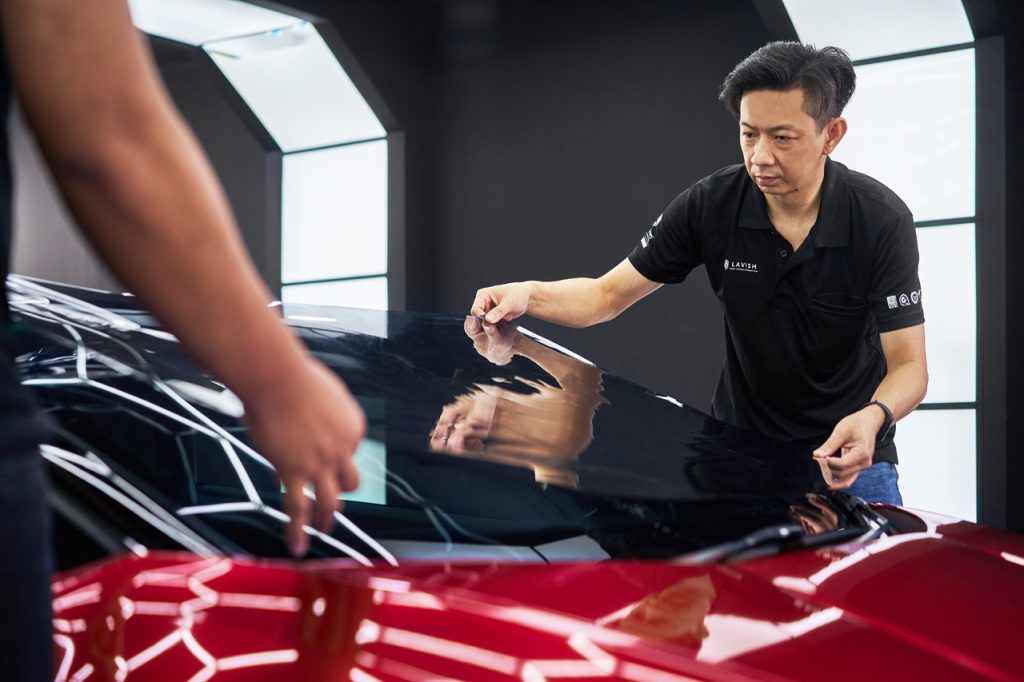
Introduction
When it comes to keeping a car looking its best, washing alone isn’t enough. Over time, paint loses its luster, showing signs of scratches, swirl marks, and oxidation. That’s where car polish comes in. Unlike a simple wash, polishing restores depth, clarity, and shine to the paint, making a vehicle look fresh and well cared for.
This guide will walk you through everything you need to know, from the types of polish available to the benefits, application techniques, and how high gloss car polish can take your vehicle’s finish to the next level.
What is Car Polish?
Car polish is used to remove imperfections such as swirl marks, minor scratches, and oxidation from the paint surface, restoring a smoother, shinier finish. It’s important to note that car polish is not the same as car wax or ceramic coating:
- – Polish = corrects paint (restores shine and removes defects).
- – Wax or Coating = protects paint (adds a layer of defense against UV rays, dirt, and water).
Think of polish as skincare exfoliation: it clears away imperfections so protective products can do their job more effectively.
Want a deeper breakdown of how polish compares with wax and ceramic coating? Check out our detailed guide here: Ceramic Coating, Wax, or Polish: Which is Better for Your Car?
Benefits of Car Polish

Polishing offers several benefits that go beyond surface-level aesthetics:
1. Restores Paint Clarity
Over time, the paint can become cloudy. Car polish removes dullness, restoring vibrancy.
2. Removes Imperfections
Fine scratches, swirl marks, and oxidation can all be corrected with polish, improving overall paint condition.
3. Improves Gloss and Shine
A freshly polished car reflects light more evenly, making the paint look newer and more luxurious.
4. Prepares the Surface for Protection
By smoothing the clear coat, polish ensures wax, sealants, or coatings bond better, lasting longer and protecting more effectively.
Types of Car Polish
Car polishes generally fall into two main categories, each serving different purposes:
1. Compound Polish
This is a stronger, more abrasive polish designed to correct deeper scratches, heavy swirl marks, and stubborn oxidation. While effective, it must be used carefully to avoid removing too much of the clear coat.
2. Finishing Polish
A gentler polish with fine abrasives that refine the paint surface, eliminate light imperfections, and restore shine. It’s often used as the final step before applying a protective wax or sealant.
Some products also combine polish with protection (all-in-one formulas), but these typically don’t deliver the same level of correction or shine as dedicated polishes.
Car Polish vs. High Gloss Car Polish
Not all polishes are created equal. While a regular car polish focuses on correction, high gloss car polish is designed to produce an exceptional mirror-like finish.
1. Regular Car Polish
Best for restoring everyday vehicles, removing imperfections, and prepping for protection.
2. High Gloss Car Polish
Specially formulated for those who want maximum shine and reflectivity. It’s often used by enthusiasts, at car shows, or for anyone looking to achieve that showroom-quality finish.
If your goal is a flawless, high-reflection surface, a high gloss car polish is the go-to choice.
How to Apply Car Polish Correctly
Polishing can be done at home or by a professional, but proper technique is crucial for good results. Here’s a general step-by-step approach:
Step 1 – Wash and Dry the Car
Dirt or debris left on the surface can cause scratches during polishing. Always start with a clean, dry car.
Step 2 – Choose the Right Application Method
- – Hand Polishing: Suitable for small areas or light work.
- – Machine Polishing: More consistent and effective, especially for deeper imperfections.
Step 3 – Apply in Small Sections
Work on small areas at a time, applying a thin layer of polish with circular motions (hand) or overlapping passes (machine).
Step 4 – Buff and Inspect
Once the polish begins to haze, buff it off with a clean microfiber cloth. Inspect the area and repeat if necessary.
How Often Should You Polish Your Car?
Polishing too frequently can wear down the clear coat, so moderation is key.
- – General Rule: Once or twice per year is usually enough.
- – More Often: If the car is exposed to harsh sunlight, rain, or pollution daily.
- – Less Often: For cars stored indoors or driven occasionally.
Regular waxing or coating in between polishes helps maintain the shine and reduce the need for frequent correction.
Common Mistakes to Avoid
Many car owners make errors when polishing, which can harm rather than help the paint. Avoid these pitfalls:
1. Over-Polishing
Polishing too often can thin the clear coat, permanently damaging the paint.
2. Using Polish as a Protector
Remember, polish restores appearance but doesn’t protect. Always follow up with wax, sealant, or coating.
3. Working in Direct Sunlight
Heat causes polish to dry too quickly, making it harder to buff and potentially leaving streaks.
4. Skipping the Wash Step
Polishing on a dirty surface can grind dirt into the paint, creating new scratches.
Choosing the Right Car Polish for Your Needs

With so many products available, here are key points to consider:
A) Car Age and Paint Condition
Older cars with visible imperfections may need a compound polish, while newer cars benefit from a finishing polish.
B) Desired Finish
If you want a deep, mirror-like reflection, look for high gloss car polish.
C) Product Quality
Stick to reputable brands that are designed for automotive use. Cheaper polishes can sometimes do more harm than good.
D) Ease of Use
Hand-friendly polishes may be better for beginners, while machine-specific products deliver professional-level results.
Why Choose Professional Car Polishing?
While DIY polishing can improve your car’s appearance, achieving a flawless and safe result is not always straightforward. Professional detailers have access to advanced equipment, premium products, and the expertise needed to bring out the best in your car’s paint. Using specialized dual-action or rotary polishers, they can correct imperfections evenly without the risk of damaging the clear coat.
They also rely on high-quality compounds and high gloss car polish formulas that deliver a deeper, longer-lasting shine than most consumer products. Most importantly, professionals understand the unique requirements of different paint types and conditions, ensuring precise and safe application every time. Choosing a professional service not only saves you time and effort but also guarantees a showroom-quality finish that DIY methods often struggle to match. For car owners who want the very best results, leaving polishing in the hands of experts like LAVISH® is the smarter choice.
Maintenance and Care Tips
Polishing restores shine but maintaining that glossy finish requires regular care. Here are some tips to keep your car looking its best after polishing:
A) Wash Regularly and Gently
Use a pH-balanced car shampoo and a microfiber wash mitt to prevent new swirl marks. Avoid harsh detergents that strip away protective layers.
B) Dry Properly
Always dry the car with a clean microfiber towel to reduce water spots. Air drying can leave mineral deposits that dull the finish.
C) Add Protection
Since polish does not provide long-term protection, always follow up with a wax, sealant, or ceramic coating. This locks in the shine and protects against UV rays, dirt, and water.
D) Avoid Harsh Conditions
Whenever possible, park in shaded areas or under cover. Prolonged sun exposure and acid rain can accelerate paint fading.
E) Schedule Regular Detailing
For most vehicles, polishing once or twice a year is ideal. In between, use wax, sealant, or ceramic coating to maintain protection and shine.
Conclusion
Polishing is one of the most effective ways to bring back life and shine to your car’s paint. While regular car polish corrects imperfections and restores clarity, high gloss car polish takes it a step further, creating that dazzling, showroom-ready reflection.
Used correctly and paired with protective products like wax or coatings, polishing keeps your car looking its absolute best. Whether you’re maintaining a daily driver or preparing for a special showcase, the right polish can make all the difference.
Don’t Miss Out on LAVISH® 4-in-1 Full Car Protection Package Promo!

If you want more than just a polished shine, LAVISH® is offering a limited-time 4-in-1 Full Car Protection Package that gives your car everything it needs to look stunning and stay protected — all at a special promotional price of RM1,499 (worth RM2,696).
This package includes:
- Guardian Series Nano Ceramic Tint – Blocks up to 80% of heat and 99.9% of harmful UV rays, with tint options of 30%, 50%, or 80%.
- Graphene Ceramic Plus + 9H Coating – Adds an incredible gloss finish while providing resistance against oxidation, stains, and scratches.
- Nano TPU Paint Protection Film (PPF) – Protects high-impact areas like the bumper, door cups, and door edges from chips and scratches.
- High Gloss Polishing – Restores and enhances your car’s paintwork, leaving it with a showroom-quality shine.
On top of the savings, Lavish offers 0% instalment plans (up to 12 months) and Buy Now Pay Later (BNPL) options, making it easier than ever to give your car the protection it deserves.
Plus, all products and services are backed by internationally recognized certifications including SGS, TUV, IAQ, and ISO 9001, ensuring world-class safety and performance.
👉 Check out the 4-in-1 Promo Package here and secure your slot before it ends.
Frequently Asked Questions (FAQ)
1. How often should I polish my car?
Polishing should be done in moderation to protect the clear coat. For most vehicles, once or twice a year is enough. Cars exposed to harsh sunlight or environmental contaminants may need it slightly more often, while cars stored indoors may only require polishing once a year.
2. Is car polish the same as car wax?
No. Car polish corrects paint by removing imperfections and restoring shine, while car wax protects paint by adding a protective layer against UV rays, dirt, and water. For best results, polish first and then apply wax or coating for protection.
3. Can polishing remove scratches completely?
Car polish can remove or reduce the appearance of light to moderate scratches, swirl marks, and oxidation. However, deeper scratches that penetrate the clear coat may require paint correction or professional repair.
4. What is high gloss car polish?
High gloss car polish is a type of finishing polish designed to maximize shine after imperfections have been corrected. It enhances the depth and clarity of your paint, leaving a sleek, mirror-like finish.
5. Is DIY car polishing safe?
DIY polishing can improve appearance if done carefully, but there are risks such as using the wrong product, applying too much pressure, or over-polishing. For long-lasting, flawless results, professional polishing is recommended.
6. How long does car polishing last?
The results of car polishing usually last 6–12 months, depending on driving conditions, environmental exposure, and whether protective products like wax, sealant, or ceramic coating are applied afterward.
7. Does car polishing damage the paint?
When done correctly and in moderation, polishing is safe. Over-polishing, however, can thin out the clear coat. That’s why professional application is the safest option for lasting results.